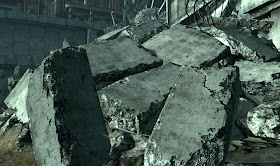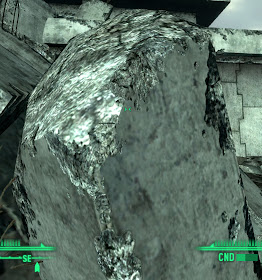Dead Space
One of the stand out graphical features to me for Dead Space is dynamic shadows. All lights and shadows are dynamic. The shadows are projected or cube shadow maps depending on the light. It looks like bilinear filtering which makes the shadows look very pixelated and nasty at times. They really take advantage of the shadows being dynamic though by having objects and lights move around whenever they can. Swinging and vibrating light positions are abundant. For large lights the resolution really suffered and the players shadow could reduce to blocks.
Coronas and similar effects were used a lot and looked great. With bloom being all the rage to portray bright objects it's a nice slap in the face that the old standbys can sometimes get a lot better results than the new fancy system. Similar tricks were used to get light beams through dusty corridors by using sheets that fade out as you get near them. This masks their flat shape well. It seems the artists went to town with this effect making different light beam textures for different situations. Foggy particle systems were also used that faded out when you get near them.
David Blizard, Dead Space's lighting designer, claimed their frame budget for building the deferred lighting buffer was 7.5ms, 4ms for building the shadow buffers, and 2ms for post processing including bloom and an antialiasing pass which means they are not using multisampling. For ambient light there is baked ambient occlusion for the world that modulates an ambient color coming from the lighting.
Mirrors Edge
Although it uses the Unreal engine it looks distinctly not like any other Unreal game or for that matter any other game out. This is due to its "graphic design" looking art style. Tech wise this relies heavily on global illumination. For this they replaced the normal lightmap generation tool from Unreal with Beast. From what I've seen in the first hour or so the only dynamic shadows are from characters and they are modulate ones. All environment lighting is baked into the lightmap with Beast. It looks like they're at a higher resolution than I've seen used before. My guess is they sacrificed a larger portion of their texture memory and added streaming support for the lightmaps. It has auto exposure which I haven't seen from an Unreal game before. All of the reflections but one planer one were cube maps which caught me a little by surprise because DICE had talked about doing research into getting real reflections working. Overall I was impressed. You could tell there was a very tight art / tech vision for the game.
Fallout 3
The world in Fallout 3 is stunning. Tech side I don't see much improved from Oblivion. Maybe most of the changes are under the hood to get more things running faster but I don't see much different, just a few odds and ends. It does seem like the artists have really grown and they have come up with good ways for portraying the things they needed to.
A few things stood out to me. First is the light beams. This is a common new technique of using a shader that fades out the edges of a cone like mesh and some other stuff to portray a light cone. The first place I saw it was Gears of War but it was used heavily and well in Fallout 3.
 Second was the grass that was done with many grass clump models with variation. The textures had a darkened core to simulate shadowing and with AA on they used alpha to coverage and looked great. So many games use just one grass sprite to fill in grass. No matter how dense you can get it it will not look right. Grass needs variation in size, color, texture, density and shape. Great job, it's some of the best grass I've seen.
Second was the grass that was done with many grass clump models with variation. The textures had a darkened core to simulate shadowing and with AA on they used alpha to coverage and looked great. So many games use just one grass sprite to fill in grass. No matter how dense you can get it it will not look right. Grass needs variation in size, color, texture, density and shape. Great job, it's some of the best grass I've seen. The last thing that stood out to me was their crumble decals (don't know what else to call them). To portray crumbling damaged stone and concrete, alpha tested normal mapped decals were placed on the edges of models. It looks like the same instanced model was placed around with different placement of these crumble decals. It added both an apparent uniqueness to the models as well as broke up their straight edges. There was quite a few times I was fooled into thinking some perfectly straight edge was tessellated when it was just effective use of these decals. Also of note is that these decals will fade out in the distance often before anything else LODs. There was likely a system to handle these decals specially.
The last thing that stood out to me was their crumble decals (don't know what else to call them). To portray crumbling damaged stone and concrete, alpha tested normal mapped decals were placed on the edges of models. It looks like the same instanced model was placed around with different placement of these crumble decals. It added both an apparent uniqueness to the models as well as broke up their straight edges. There was quite a few times I was fooled into thinking some perfectly straight edge was tessellated when it was just effective use of these decals. Also of note is that these decals will fade out in the distance often before anything else LODs. There was likely a system to handle these decals specially.
 Overall, the art was nice but the tech was underwhelming. They really should have shadows by this point. There is no world shadows of any sort. With this addition I think the game would look twice as good as it does.
Overall, the art was nice but the tech was underwhelming. They really should have shadows by this point. There is no world shadows of any sort. With this addition I think the game would look twice as good as it does.
I would like to add that Dead Space has some nice DoF. They are pretty restrictive about when they use it (when the camera is directly behind the player at depots and in large rooms), but when they do it works well. I'm not a huge gamer but I think this is the first game I've played where DoF actually added something to the game. In many games, such as Assassin's Creed, the DoF usually actually detracts from the game play due to lack of constraints or poor heuristics in calculating the effect.
ReplyDeleteI was also really into the 3D UIs which account for parallax between the UI components and the background based on the camera angle relative to the UI.
I agree. The DoF I noticed in the same situations as you. I'm guessing it was to control the performance. It looks to be multiple samples from a blurred blur. This gets them the ability to change the blur size. That ends up looking quite a bit better than the typical lerp between sharp and blurred which gives things a fuzzy soft focus look.
ReplyDeleteI really liked the GUIs too. There is stacking in that the GUI elements have a depth and are drawn at different distances from the GUI surfaces. I didn't include it in my write up because it seemed more design than tech. I think GUIs in the world are going to start showing up in all sorts of games now. It's a neat idea.